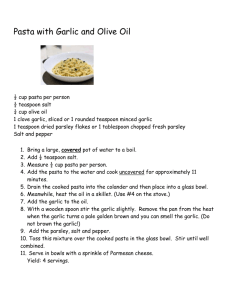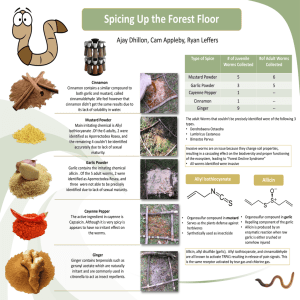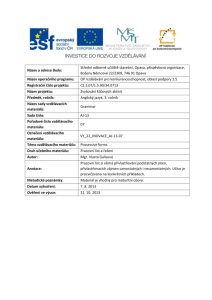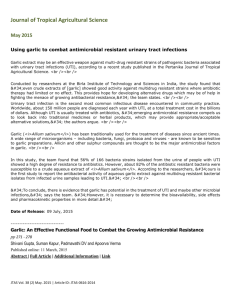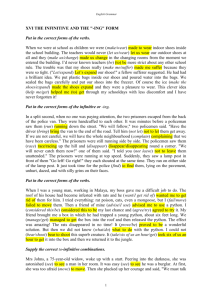effectiveness of garlic in fighting bacteria
advertisement
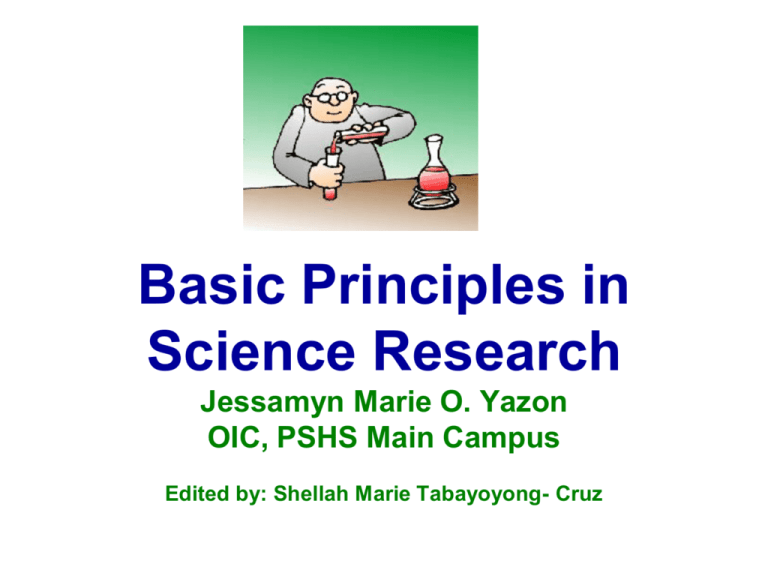
Basic Principles in Science Research Jessamyn Marie O. Yazon OIC, PSHS Main Campus Edited by: Shellah Marie Tabayoyong- Cruz Materials Science Topics • Testing the stiffness, strength, and other properties of materials such as wood, metal, and wire • Analyzing and comparing different kinds of cleaning or filtering products (for instance, the most effective antibacterial solution) • Testing the flammability of different textiles, such as fabrics or construction materials • Investigating viscosity or lubricating properties of fluids • Learn how to make metals stronger • Combination of materials that can make a strong paper bag • Fishing line strength Materials Science Topics • Hygrometer for hair • Tower out of pasta • Bacterial resistant materials and the best disinfectant • How can straw make a sturdy building • Anti-magnets • Mosquito mats • Materials for sound barriers • Biodegradable plastics Some Areas/Topics for Research • • • • • • • • • • Nutrition and food production Control of environmental pollution Non-conventional sources of energy Process technology Microbiology Natural pesticides/ insecticides Agricultural productivity Aquaculture Health and medicine Basic research Scientific Writing Nature It is a form of writing called expository It involves a reporting and an interpretation of facts Purpose To inform or communicate new findings or discoveries To allow readers to perceive what the author had in mind and be persuaded that the interpretation presented is the correct one Style in Scientific Writing • • • • • • • • Accurate Brief Clear Objective Honest Direct Confident Efficient Style in Scientific Writing • Honest: Successes, as well as failures and mistakes are reported • Direct: explicit mention of what is important and expected, no room for various interpretations or meanings • Confident: the writer is an authority on the subject since he is the one who has carried it out • Efficient: through the use of a standard style and format Style in Scientific Writing • Accurate: the facts are given without distortion • Brief: writer omits unnecessary words • Clear: easily understood, no ambiguities, misdirection or wandering • Objective: the discussion and evaluation of findings is made without bias Research Paper • • • • • • • • • • Title Abstract Acknowledgements Table of Contents Introduction Review of Related Literature Materials and Methods Results and Discussion Summary and Conclusion Recommendations SOURCES OF INFORMATION PRIMARY SOURCES (original object or document, a raw material & first-hand information) • historical documents • legal documents • eyewitness accounts • results of experiments or empirical studies •statistical data found in scholarly articles or conference papers •interviews •field work •questionnaires •surveys SECONDARY SOURCES (interpretation, an analysis, comment, discourse or summary of the original material/primary source) •Articles in newspapers or popular magazines •Documentaries •Book or movie reviews •Articles found in scholarly journals that discuss/evaluate someone else’s original study SOURCES OF INFORMATION TERTIARY SOURCES (compilations or digests of factual material, commonly understood as reference sources) Note: There is no clear distinction between primary & secondary sources. A secondary source may be a primary source depending on how or why it is being used. • almanacs • databases and indexes • dictionaries •Directories •Encyclopedias •Websites of general interest •Book of abstracts that belong to this category Tertiary sources are NOT considered to be acceptable material for academic researches. Research Paper • Title Must reflect the factual content of the paper Brief, accurate, and complete • Abstract Overviews of facts, results, conclusions and recommendations of an article May be written in 100 to 200 words Research Paper • Introduction Background of the Study Statement of the Problem Significance Scope and Limitations Provides the theoretical / historical background States how work is different to those previously done Background of the Study • Provides a GENERAL overview of the topic of study (1st paragraph) to introduce the main idea(s) • Includes clear, focused, accurate and detailed information to understand the science investigated during the study in the middle paragraph(s) • Provides cited support from external resources • Previews the experiment in the last paragraph by summarizing the purpose and method for data collection NOTE: 3 to 4 paragraphs; 1st paragraph(broad & general look), then getting increasingly more specific to your own experiment in the 2 nd, 3rd or 4th paragraph. Remember NOT to use “I”, “we” “our”... EFFECTIVENESS OF GARLIC IN FIGHTING BACTERIA Herbs and spices have traditionally been used in cooking as they add flavor to our food. These herbs and spices have also been known to many cultures for their medicinal properties. The oils that are extracted from these spices and herbs are found to be effective in killing bacteria and viruses. (general view of herbs& spices) Garlic is known to have the ability to fight bacteria and viruses. It is known to be affective against a wide range of bacteria and also has the ability to combat the common cold. The antimicrobial substance in garlic is called allicin. Allicin consists of approximately 0.3% 0.5% of the garlic. To maintain the antibacterial properties of garlic, it must be consumed or applied as raw garlic because cooking will destroy the allicin. (studies about garlic) Frequent use of antibiotics causes the microbes to develop resistance against the drugs. Studies have shown that garlic has proven its ability to fight against bacteria that has developed resistance to antibiotics. The use of garlic along with other forms medication has been also known to enhance the effectiveness of these drugs. (studies about antibiotics) This project was done to find out if garlic is effective in killing bacteria. This will help us understand the effectiveness of home remedies such as the use of natural herbs (including garlic) for medicinal purposes. (your own experiment) EFFECTIVENESS OF GARLIC IN FIGHTING BACTERIA • STATEMENT OF THE PROBLEM This study aims to answer the questions: 1) Can garlic be effective in eliminating or killing bacteria? 2) Can it prevent the further growth of bacteria? • HYPOTHESIS Garlic will kill bacteria and prevent its further growth SIGNIFICANCE OF THE STUDY • Creates a perspective for looking at the problem • Points out how your study relates to the larger issues • Questions: Why is your study important? To whom is it important? What benefit(s) will occur if your study is done? EFFECTIVENESS OF GARLIC IN FIGHTING BACTERIA • This study was done to find out if garlic is effective in killing bacteria. This will further help one understand the effectiveness of home remedies such as the use of natural herbs (including garlic) for medicinal purposes. SCOPE and LIMITATIONS/DELIMITATIONS • • • • • Includes the specific variables of the study the location of the study the samples the respondents weaknesses of the study which are beyond the control of the researcher Note: defines where and when the study is conducted and who the subjects are EFFECTIVENESS OF GARLIC IN FIGHTING BACTERIA This study focused on the utilization of the extract from garlic as anti-bacterial agent on the Escherichia Coli (E. Coli) bacteria. Experimentation was done in the school laboratory. Safety precautions were taken into consideration like pouring some bleach into the petri dishes to kill all the bacteria. DEFINITION OF TERMS • Antimicrobial – capable of destroying or inhibiting the growth of disease-causing microorganisms • Antibiotics – a medicine (such as penicillin or its derivatives) that inhibits the growth of or destroys microorganisms • Microbe – a microorganism, especially a bacterium causing disease or fermentation • Bacteria – a member of a large group of unicellular microorganisms lacking organelles and an organized nucleus, including some that can cause disease. DEFINITION OF TERMS • Virus – an infective agent that typically consists of a nucleic acid molecule in a protein coat is too small to be seen by light microscopy. • Petri dish – a shallow, circular, transparent dish with a flat lid, used for the culture of microorganisms SOURCES OF INFORMATION PRIMARY SOURCES (original object or document, a raw material & first-hand information) • historical documents • legal documents • eyewitness accounts • results of experiments or empirical studies •statistical data found in scholarly articles or conference papers •interviews •field work •questionnaires •surveys SECONDARY SOURCES (interpretation, an analysis, comment, discourse or summary of the original material/primary source) •Articles in newspapers or popular magazines •Documentaries •Book or movie reviews •Articles found in scholarly journals that discuss/evaluate someone else’s original study SOURCES OF INFORMATION TERTIARY SOURCES (compilations or digests of factual material, commonly understood as reference sources) Note: There is no clear distinction between primary & secondary sources. A secondary source may be a primary source depending on how or why it is being used. • almanacs • databases and indexes • dictionaries •Directories •Encyclopedias •Websites of general interest •Book of abstracts that belong to this category Tertiary sources are NOT considered to be acceptable material for academic researches. Research Paper • Review of Related Literature Serves to review scientific literature Explain choice of materials or methodology Show rationale for investigation Simply a compilation of results of studies on the SAME SUBJECT MATTER as your research or subjects which is relevant to your topic. MAIN PURPOSE: 1) analyze scientific works 2) find out how much research has been done 3) justify the need for more studies on the topic 4) fill-in existing gaps 5) substantiate existing acts 6) get new ideas and approaches Research Paper • Review of Related Literature Key to well written review of related literature: effective NOTE TAKING • Read one source at a time highlighting the important parts • Use 5 x 8 index card (color-coded) *optional • Paraphrase all information in order not to commit plagiarism • Avoid using abbreviations; take the information word for word • Each note record the following: author’s name, title of reference (book, article, interview, etc), publication information (publisher, place, date of publication, volume number, issue number), page number, personal comments Research Paper (RRL) CITATIONS (based on the Publication Manual of American Psychological Association – APA) • APA-style uses the parenthetical author-year method of citation Research Paper (RRL) Author’s surname followed by the year of publication in parenthesis is included in the quotation or sentence. • According to Montefalcon (2011), the compressive strength of hollow blocks using green mussel shell as partial substitute for sand aggregate is not directly proportional to curing time. Author’s name is not included in the sentence. Author’s name followed by the year of publication enclosed in parenthesis is written AFTER the sentence. • The comprehensive strength of hollow blocks using mussel shelll as partial substitute for sand aggregate is not directly proportional to curing time (Montefalcon 2011) Research Paper (RRL) • The same format may be used if there are at most five authors using the connective “and” and the ampersand for the first and second case, respectively. Ex. The study conducted by Rustom, Badarnah, and Barahma (2007) showed the possibility of utilizing the recycled crushed aggregates of the construction and demolition wastes in engineering applications in Gaza Strip. Research Paper (RRL) • If the work will be cited again, them mention only the surname of the first author followed by the word et.al. Ex. The study conducted by Rustom et al (2007) showed the possibility of utilizing the recycled crushed aggregates of the construction and demolition wastes in engineering applications in Gaza Strip. Research Paper (RRL) • If the information is a DIRECT QUOTATION, the page number must be indicated. Quotation marks must also be used. Ex. According to Montefalcon (2011), “the compressive strength of hollow blocks using green mussel shell as partial substitute for sand aggregate is not directly proportional to curing time”. (p.25) Note: Longer direct quotations exceeding 40 words must be written double spaced in a free standing block without quotation marks with the first line indented five spaces. EFFECTIVENESS OF GARLIC IN FIGHTING BACTERIA • Garlic has been used for medicinal purposes since ancient times, all over the world. Many cultures such as the Egyptians and the Chinese have used garlic for these purposes. Recently, many worldwide studies have confirmed that garlic can reduce blood cholesterol levels. Other studies have proven that it can shrink tumors from cancer with diallyl disulfide (DADS), an element found in garlic. EFFECTIVENESS OF GARLIC IN FIGHTING BACTERIA • The substance in garlic that kills the bacteria is allicin. Allicin is made up of about 0.3% - 0.5% of the garlic. In particular, allicin destroys the growth of microorganisms that cause disease. These are called pathogenic microorganisms. Garlic (Allium sativum Linn.) is one of those plants that was seriously investigated over the years. It has been used for centuries to fight infections (Onyeagba et al.,2006). The early Egyptians used it to treat diarrhoea, the ancient Greeks used it to treat intestinal and extraintestinal diseases, while the ancient Japanese and Chinese used it to treat headache, flu, sore throat and fever. In Africa, particularly in Nigeria, it is used to treat abdominal discomfort, diarrhoea, otitis media and respiratory tract infections (Ankri and Mirelman, 1999; Jaber and Al-Mossawi, 2007). The phytochemical constituents of garlic have been established in previous studies (Farbman, et al., 1993; Cavallito and Bailey, 1994; Ankri and Mirelman, 1999; Prados-Rosales et al., 2003). The antimicrobial properties of garlic were first described by Pasteur in 1958, and since then, research had demonstrated its effectiveness against bacteria, protozoa, fungi and some viruses (Jaber and Al-Mossawi, 2007) EFFECTIVENESS OF GARLIC IN FIGHTING BACTERIA • Previous studies have also indicated that garlic has antineoplastic,cardiovascular, immuno-stimulatory and hypoglycaemic properties (Sato and Miyata, 1999). The development of resistance to most of the antimicrobial agents, the emergence of newer diseases and the resurgence of older diseases thought to be brought under control necessitate the search for newer agents. However, in spite of the volumes of literature describing the usefulness of garlic in treating infections, there is little or no work done to assess the usefulness of garlic to fight hospital based infections. The aim of this work was to study the effecttiveness of garlic against some microorganisms that frequently cause nosocomial infections in the 750-bed referral hospital. EFFECTIVENESS OF GARLIC IN FIGHTING BACTERIA • Many studies have implicated Staphylococcus aureus, Escherichia coli, Streptococcus pneumoniae and Pseudomonas aeruginosa as leading causative agents of both community and hospital acquired infections (Amita et al.,2003; Branger et al., 2005; Oteo et al., 2005). E. coli is found in the intestines of humans and animals. It takes a long time to recover if one gets sick from these bacteria. Millions of children in the world have died from persistent diarrhea due to bacterial infections such as E. coli. Food can be infected with E. coli due to unclean water. Many people get sick from contaminated food. Typically, bacterial infections are treated with antibiotics. However, numerous bacteria are becoming resistant to antibiotics. As a result, “superbugs” are being created. A superbug is a pathogenic bacterium that has mutated, and develops resistance to antibiotics. In order to prevent this from happening, nutritional supplementation might assist in battling bacteria. This study was conducted to see if garlic could prove to be beneficial when fighting E. coli bacteria. Research Paper • Materials and Methods Presentation must be in chronological order Provide all needed details especially if new, allows others to use your methodology Methodology PROCEDURE For this experiment, the independent variable is the composition of the test specimen. The dependent variable is the growth of the bacteria colony. This is determined by measuring the size of the growth using a ruler. The constants (control variables) are the room temperature, the amount of sunlight and the ingredients in the petri dish agar. The petri dish prepared with blood agar must be stored in the refrigerator. Before the start of the experiment, remove the petri dish from the refrigerator to allow it to reach room temperature. Methodology Three test specimens are made and labelled as described below: Specimen A – 100 ml milk is measured using the measuring cup and poured into test tube A. With the marker pen, label this test tube A. Specimen B - 100 ml milk is measured using the measuring cup and poured into test tube B. With the marker pen, label this test tube B. Using a toothpick, add a small amount of E. Coli specimen to test tube B. Shake the test tube to mix the specimen thoroughly. Methodology • Method of Research: Pure research (experimental) • Materials The materials required for this experiment: 3 agar petri dishes prepared with blood agar 300 ml milk 1 measurement cup (100 ml) 5 pieces garlic ground and juice extracted (approx 5 ml) 3 test tubes 4 syringes Escherichia coli (E. Coli) specimen 2 toothpicks 1 permanent marker pen Methodology Specimen C – 100 ml milk is measured using measuring cup and poured into test tube C. With the marker pen, label this test tube C. Using a toothpick add a small amount of E. Coli specimen to test tube C. Next, add the extracted garlic juice to test tube C. The test tube is shaken to mix the specimen. The specimens in test tubes A, B and C are allowed to incubate for 2 hours. Mark the 3 petri dishes – A, B and C. Remove the lid and using the syringe, extract 10 ml of the sample mixture from test tube A and place it in the center of petri dish A. Methodology Use a new syringe to extract 10 ml sample from test tube B and place it in dish B and repeat for test tube C/dish C. Replace the petri dish lids and store the petri dishes in a cool and shaded place. The diameter of the E. Coli colony is measured everyday for 5 days and recorded. Research Paper • Results Presentation of overall description or summary of the experiments are their results Data can be organized into: tables, photographs, drawings, or graphs Research Paper • Discussion Say what the results mean Emphasize interpretation of the data Present the principles, relationships and generalizations shown by the results Point out any exceptions or lack of correlation and to try to explain these observations Show how work agrees/does not agree with previous work Effect of Garlic in Killing E. Coli bacteria Chapter IV: Analysis and Interpretation of Data Legend: A – 100 ml milk B – 100 ml milk & E. Coli C – 100 ml milk, E. Coli & garlic extract Graph Interpretation of Data • The results show that test tube B with milk & E. Coli specimen had the largest colony of bacterial growth whereas test tube C with milk, the E. Coli specimen and garlic extract did not show any signs of bacterial growth. Test tube A showed some small signs of contamination probably due to contamination during the incubation period. Research Paper • Summary and Conclusion Recaps the important highlights of the study Describes the important findings Links the findings to the objectives of the study (I.e. Did you achieve your goals? Did you answer your problem?) Conclusion The hypothesis that the presence of garlic will kill bacteria and prevent its growth is proven to be true. The antimicrobial properties of herbs and spices are useful for medicinal purpose and also for the preservation of food. However, it is also true that different spices are effective in providing resistance and protection against different types of microbes. Research Paper • Recommendations Describes how the research study can be further improved Discusses other related studies that can be done in the future A TIP: • The secret to good writing… is in the RE-WRITING! Recommendation The researchers would recommend the following to those who would want to repeat the experiment: a) Boil the garlic before extracting the garlic juice. Observe the differences in your results. b) Try to repeat the experiment using onions instead of garlic Used Cooking Oil as an Additive Component of Candle Abstract The study aims to produce a low-priced, highquality candle by using used cooking oil as a major component. The following candle compositions were used: 100 percent paraffin wax; 90 percent paraffin and 10 percent oil; 80 percent paraffin and 20 percent oil; 70 percent paraffin and 30 percent oil; 60 percent paraffin and 40 percent oil; 50 percent paraffin and 50 percent oil. The firmness, texture, and light intensity of the candles were tested and compared. Used Cooking Oil as an Additive Component of Candle Results of the tests showed that the candle made from 100 percent paraffin wax had the lowest melting rate, lowest amount of melted candle, and a light intensity of 100 candelas (cd). The 90:10 preparation had the next lowest melting rate and amount of melted candle. The other preparations ranked according to the proportion of used cooking oil in the candle, with the 50:50 preparation performing least comparably with the 100 percent paraffin wax candle. Writing the Bibliography • Entries in the bibliography are typed double-spaced and arrange alphabetically according to authors’ surnames. • Subsequent lines should be indented five spaces from the margin. • Each entry is separated by a double space from the next entry. Formats for common types of sources of information PRINTED SOURCES BOOK FORMAT Author’s last name, first initial. (Year of publication). Title of work:Capital letter also for subtitle. (edition). Location:Publisher Author’s last name, first initial., Author’s last JOURNAL/PERIODICAL name, first initial & Author’s last name, first initial. (Year). Title of article. Title of Periodical, volume number (issue number), pages EXAMPLE Silverio, A.A. (2011). Exploring Life Through Science:Physics. (2nd ed.) Quezon City: Phoenix Publishing House. Bogert, L.W.J. and van Lieshout, J.J. (2005). Non-invasive pulsatile arterial pressure and stroke volume changes from the human finger. Experimental Physiology, 90, 437-446. Formats for common types of sources of information PRINTED SOURCES ENCYCLOPEDIA/ DICTIONARY UNPUBLISHED DISSERTATION FORMAT EXAMPLE Author’s last name, first intial. (Date). Title of Article. In Title of Encyclopedia (Volume, pages). City of publication: Publishing company. Bodash, L.C. (1993). Atom. In Grolier Encyclopedia (2, 304310). Connecticut: Grolier Incorporated. Author’s last name, first initial (Year). Title of dissertation. (Unpublished doctoral dissertation.) Name of Intstitution, Location. Montefalcon, K. (2011). A preliminary study on the use of Perna Viridis (Philippine green mussel) waste as aggregate for non-load bearing hollow blocks. (Unpublished undergraduate thesis). University of Santo Tomas, Philippines. Formats for common types of sources of information ONLINE SOURCES e BOOK PERIODICAL/ JOURNAL FORMAT EXAMPLE Author’s last name, first initial., (Date of publication). Title of work. Retrieved from full URL. Jarell, M.A. (2001). A course in solid state physics. Retrieved from http://www.phys.lsu.edu/˜jarr el/COURSES/SOLID_STAT E_HTML/course_solid.html Author’s name. (Date of publication). Title of articl. Title of Periodical, volume number, Retrieved month day, year from full URL Rustom, R., Taha, S., Badarnah, A., & Barahma, H. (2007). Properties of recycled aggregate in concrete and road pavement applications. The Islamic University Journal. (Series of Natural Sciences and Engineering), 1 5 (2), Retrieved from http://www.iugaza.edu.ps/ara /research/ Preparations for the Science Fair Preparations for the Science Fair • Know contest rules (e.g. poster size, time limit for presentation, etc.) and deadlines • Plan and prepare poster exhibit • Prepare and practice oral presentation – Anticipate answers to questions • Be ready to accept and incorporate constructive criticisms Tips on Poster Presentation References Burns R. 2000. Introduction to research methods. London. Sage Publications. Cruz, J. M. 1999. Scientific writing. Philippine Science High School. Cruz, J. M and A. Chupungco. 2001. Science and technology research manual. Philippine Science High School. UP NISMED and DOST-SEI. 2005. Course notes in Training of trainors in science and mathematics investigations. October 24 – 29, 2005, UP NISMED, Diliman, Quezon City. Silverio, A. 2011. Physics Investigatory Project. Exploring Life Through Science. Second Edition. Acknowledgement Ms. Karen U. Hipol

